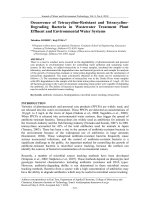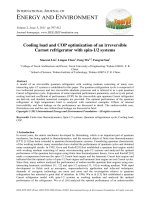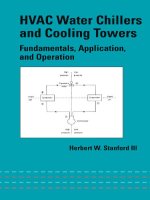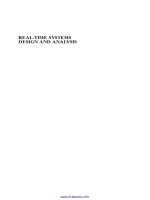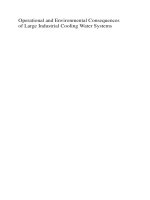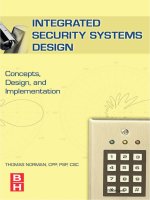COOLING TOWERS AND CONDENSER WATER SYSTEMS: DESIGN AND OPERATION
Bạn đang xem bản rút gọn của tài liệu. Xem và tải ngay bản đầy đủ của tài liệu tại đây (1.01 MB, 56 trang )
<span class="text_page_counter">Trang 1</span><div class="page_container" data-page="1">
<b><small>© 2005 American Standard Inc.</small></b>
<b>Cooling Towers and </b>
<b>Condenser Water Systems</b>
Design and Operation
</div><span class="text_page_counter">Trang 2</span><div class="page_container" data-page="2"><b><small>© 2005 American Standard Inc.</small></b>
<b>Cooling Towers and </b>
<b>Condenser Water Systems</b>
Design and Operation
<b>Cooling tower fundamentals</b>
</div><span class="text_page_counter">Trang 3</span><div class="page_container" data-page="3"><b>5 psia</b>
</div><span class="text_page_counter">Trang 4</span><div class="page_container" data-page="4"><b>evaporatoreconomizerP</b>
<b><sub>c</sub></b></div><span class="text_page_counter">Trang 5</span><div class="page_container" data-page="5"><b>water temperature</b>
<b>rejection rate of tower</b>
<b>Hermetic motor:100% of electricalinput</b>
<b>Open motor:electrical input× motor efficiency</b>
</div><span class="text_page_counter">Trang 6</span><div class="page_container" data-page="6"><b>Heat Rejection Example</b>
<b>For 1 ton of evaporator load:</b>
<i><b>Q = 12,000 Btu/h × (1 + 1/6.10)</b></i>
<b>= 12,000 Btu/h × (1 + 0.16)= 13,967 Btu/h</b>
</div><span class="text_page_counter">Trang 7</span><div class="page_container" data-page="7"><b>to heat rejection and condenser water flow rate</b>
<b>condenser temperature</b>
<b>condenser pressure rises</b>
<i><b>ASHRAE Terminology of HVAC&R</b></i>
</div><span class="text_page_counter">Trang 8</span><div class="page_container" data-page="8"><b>hot waterfill</b>
</div><span class="text_page_counter">Trang 9</span><div class="page_container" data-page="9"><b>Performance Factors</b>
<b>hot watertemperature</b>
<b>cold watertemperature</b>
<b>ambient wet bulb</b>
<b>towerflow rate</b>
<b>cooling tower certification</b>
<b>CTI Performance Limitscooling tower certification</b>
<b>CTI Performance Limits</b>
<b>hot water< 125°F</b>
<b>cold watertemperature</b>
</div><span class="text_page_counter">Trang 10</span><div class="page_container" data-page="10"><b>96°Fhot water</b>
<b>82°Fcold water</b>
</div><span class="text_page_counter">Trang 11</span><div class="page_container" data-page="11"><b>99°Fhot water</b>
<b>85°Fcold water</b>
</div><span class="text_page_counter">Trang 12</span><div class="page_container" data-page="12"><b>ambient wet bulb, °F0.0</b>
<b>4.08.012.016.0</b>
</div><span class="text_page_counter">Trang 13</span><div class="page_container" data-page="13"><b>100% load</b>
<b>50% loadcooling tower performance factorsApproach and Wet Bulbcooling tower performance factorsApproach and Wet Bulb</b>
<b>approach = 7approach = 16</b>
<b>cooling tower performance factors</b>
<b>Approach and Wet Bulb</b>
<b>cooling tower performance factors</b>
<b>Approach and Wet Bulb</b>
</div><span class="text_page_counter">Trang 14</span><div class="page_container" data-page="14"><b><small>© 2005 American Standard Inc.</small></b>
<b>Cooling Towers and </b>
<b>Condenser Water Systems</b>
Design and Operation
10° F ΔT for older, less efficient chillers
</div><span class="text_page_counter">Trang 15</span><div class="page_container" data-page="15"><b>Industry advisorPacific Gas andElectric CoolTools™</b>
<b>10°–15°F T single stage12°–18°F T multistage or positive displacementKelly and Chan14.2°F T for 3.6–8.3% </b>
<b>energy savings in various climates</b>
<b>ASHRAE Green Guide12°–18°F T</b>
<b>Chiller Performance8.0</b>
<b>ASHRAE Standard 90</b>
<b>(1977)(1980)<sup>90-75</sup><sup>90.1-89 90.1-99</sup></b>
<b>centrifugal>600 tons</b>
<b>screw150-300 tons</b>
<b>scroll<100 tons</b>
<b>reciprocating<150 tons</b>
</div><span class="text_page_counter">Trang 16</span><div class="page_container" data-page="16"><b>Condensing Components</b>
<b>Condenser waterpump</b>
<b>Certified selections help assure expectedchiller performance</b>
Full-load and part-load conditions
Air-Conditioning & RefrigerationInstitute (ARI)
</div><span class="text_page_counter">Trang 17</span><div class="page_container" data-page="17"><b>chilled water plant design</b>
<b>Cooling Tower Selectionchilled water plant design</b>
<b>Cooling Tower Selection</b>
<b>Cooling Technology Institute (CTI)rates tower performance</b>
<b>3960 × pump efficiency</b>
<b>kW =</b>
<b>motor efficiency0.746 × hp</b>
</div><span class="text_page_counter">Trang 18</span><div class="page_container" data-page="18"><b>… in the condenser water loop:</b>
Pipes, valves, fittings
<b>chilled water plant design</b>
<b>Base Design: 500 Tonschilled water plant design</b>
<b>Base Design: 500 Tons</b>
<b>Assumptions for our example …</b>
</div><span class="text_page_counter">Trang 19</span><div class="page_container" data-page="19"><b>0.572/tonCondenser P, ft25.7</b>
<b>Condenser flow rate, gpm/ton:3.0</b>
<b>Flow rate, gpm1500Power rating, bhp40</b>
<b>kW31.2Static head, ft13</b>
<b>Condenser flow rate, gpm/ton:3.0</b>
<b>Basedesign</b>
</div><span class="text_page_counter">Trang 20</span><div class="page_container" data-page="20"><b>Condenser flow rate, gpm/ton:3.0</b>
<b>chilled water plant design: examplePump Selection</b>
<b>chilled water plant design: examplePump Selection</b>
<b>Condenser flow rate, gpm/ton:3.0</b>
<b>Basedesign</b>
</div><span class="text_page_counter">Trang 21</span><div class="page_container" data-page="21"><b>Condenser flow rate, gpm/ton:</b>
</div><span class="text_page_counter">Trang 22</span><div class="page_container" data-page="22"><b>Flow rate, gpm15001000Power rating, bhp4025</b>
</div><span class="text_page_counter">Trang 23</span><div class="page_container" data-page="23"><b>tower fancondenser pumpchiller</b>
<b>gpmgpm<sup>3.0</sup>gpm<sup>2.0</sup>gpm<sup>3.0</sup>gpm<sup>2.0</sup>gpm<sup>3.0</sup>gpm<sup>2.0</sup></b>
<b>50% load75% load100% load</b>
</div><span class="text_page_counter">Trang 24</span><div class="page_container" data-page="24"><b>full energy cost savings </b>
<b>Reduce pipe size to cut installed cost</b>
<b>Condenser water pump must overcome pressure drops</b>
Tower static lift
Pipes, valves, fittings
<b>What if it was0 ft of head?</b>
</div><span class="text_page_counter">Trang 25</span><div class="page_container" data-page="25"><b>tower fancondenser pumpchiller</b>
<b>gpmgpm<sup>3.0</sup>gpm<sup>2.0</sup>gpm<sup>3.0</sup>gpm<sup>2.0</sup>gpm<sup>3.0</sup>gpm<sup>2.0</sup></b>
<b>50% load75% load100% load</b>
<b>*piping PD = 0 ft</b>Cost savings: $426,000 construction7.3% operation
Cost savings: $45,000 excavation, concrete6.5% operation
Cost savings: Piping
2% operation (existing tower)
</div><span class="text_page_counter">Trang 26</span><div class="page_container" data-page="26">Cost savings: $426,000 construction7.3% operation
Cost savings: $45,000 excavation, concrete6.5% operation
Cost savings: Piping
2% operation (existing tower)
two years ago
in good shape
</div><span class="text_page_counter">Trang 27</span><div class="page_container" data-page="27"><b>Chiller PlantAnalyzer</b>
</div><span class="text_page_counter">Trang 28</span><div class="page_container" data-page="28"><b>Start at 2 gpm/ton and adjust</b>
<b>Reinvest part of first-cost savings in more efficient chillers</b>
<b>chilled water plant designGuidance</b>
<b>chilled water plant designGuidance</b>
<b>The meter is on</b>
</div><span class="text_page_counter">Trang 29</span><div class="page_container" data-page="29"><b>Saving Energy–And More</b>
<b>“In addition to the electric energy savings, this chiller plant will have prevented the </b>
<b>situation where the first cost is reduced, operating cost is minimized, plus significant environmental benefits are realized as an additional benefit.”</b>
<i><b>from “A Chiller Challenge” by T. Chan</b></i>
<b><small>© 2005 American Standard Inc.</small></b>
<b>Cooling Towers and </b>
<b>Condenser Water Systems</b>
Design and Operation
<b>Cooling-towercontrol options</b>
</div><span class="text_page_counter">Trang 30</span><div class="page_container" data-page="30"><b>chiller–tower optimization</b>
<b>Control</b>
</div><span class="text_page_counter">Trang 31</span><div class="page_container" data-page="31"><b>Capacity Control</b>
</div><span class="text_page_counter">Trang 32</span><div class="page_container" data-page="32"><b>cooling tower</b>
<b>Capacity vs. Airflowcooling tower</b>
<b>Capacity vs. Airflow</b>
<b>806040200</b>
</div><span class="text_page_counter">Trang 33</span><div class="page_container" data-page="33"><b>one tower fan</b>
<b>Perfect Capacity Controlone tower fan</b>
<b>Perfect Capacity Control</b>
<b>capacity vs. airflowairflow vs. fan power</b><b>speed drive</b>
<b>variable-speed drivesingle-speed fan</b>
<b>one tower fan</b>
<b>Capacity Controlone tower fan</b>
<b>Capacity Control</b>
<b>two-speed fan:100% and 50%two-speed fan:100% and 67%</b>
</div><span class="text_page_counter">Trang 34</span><div class="page_container" data-page="34"><b>2 fans with VSDs2 single-speed fans1 single-speed fan,1 two-speed fan</b>
<b>two tower fans</b>
<b>Capacity Controltwo tower fans</b>
<b>2 fans with VSDs,modulated together2 fans with VSDs,1 to high speed first</b>
<b>two tower fans</b>
<b>Capacity Controltwo tower fans</b>
<b>Capacity Control</b>
</div><span class="text_page_counter">Trang 35</span><div class="page_container" data-page="35"><b>Invest in VFDs on all tower fans</b>
<b>Operating multiple fans at part speed saves energy</b>
full speed and the other off
<b>Sequence of Operation</b>
<b>1. When a chiller is operating and the cooling tower basin temperature rises to two (2) degrees F above the current tower leaving water setpoint, the lead cooling tower fan shall be turned on at minimum speed and the DDC control loop enabled.</b>
<b>a. When the operating fan(s) are operating at 50 percent speed, an additional fan shall be enabled and controlled at the same speed as the operating fans until all active cooling tower cell fans are enabled.</b>
<b>b. When operating fans are running at minimum speed and the tower supply water temperature is five (5) degrees below the current tower leaving water setpoint, the most lag tower fan shall be turned off.</b>
<b>c. Cooling tower fans shall have five (5) minute minimum on and off time delays.</b>
</div><span class="text_page_counter">Trang 36</span><div class="page_container" data-page="36"><b>chiller–tower optimizationControl</b>
<b>Evaporator pressure setby leaving-evaporator watertemperature</b>
<b>41.8°F</b>
</div><span class="text_page_counter">Trang 37</span><div class="page_container" data-page="37"><b>Evaporator pressure setby leaving-evaporator watertemperature</b>
<b>41.8°F</b>
</div><span class="text_page_counter">Trang 38</span><div class="page_container" data-page="38">Reduce water flow over tower—
<i>e.g., 3-way bypass into sump (not preferred)</i>
Reduce flow through condenser
<b>Tower bypass with 3-wayor 2-way valves</b>
<b>Constant flow throughchiller</b>
<b>NOT PREFERREDLonger lag time makescontrol difficult</b>
</div><span class="text_page_counter">Trang 39</span><div class="page_container" data-page="39"><b>Throttling Valve</b>
<b>Throttling valvemodulates based onrefrigerant P</b>
<b>Constant flow over tower</b>
<b>More precise control</b>
</div><span class="text_page_counter">Trang 40</span><div class="page_container" data-page="40"><b>Enables more efficientwater balancing</b>
<b>Short periods withlow flow over tower</b>
<b>Most efficient methodof controlling chillerhead pressureVFD</b>
<b>Sequence of Operation</b>
<b>… for chiller head pressure:</b>
1. The BAS shall monitor the refrigerant pressure in each chiller’s evaporator and condenser. The BAS shall use PID-based
<i>DDC control of the [chiller-condenser-pump </i>
<i>VFD][cooling-tower bypass condenser bypass valve] to maintain no </i>
valve][chiller-less than the minimum pressure differential specified by the chiller manufacturer.
</div><span class="text_page_counter">Trang 41</span><div class="page_container" data-page="41">Water-Cooled Series R Chiller Models RTHB & RTHD Condenser Water Control
<b>Tower flow range can be muchnarrower than that of chiller</b>
<b>500-toncooling towerFlow</b>
</div><span class="text_page_counter">Trang 42</span><div class="page_container" data-page="42"><b>Consult tower manufacturer … Specify limits</b>
<b><small>© 2005 American Standard Inc.</small></b>
<b>Cooling Towers and </b>
<b>Condenser Water Systems</b>
Design and Operation
<b>System </b>
<b>optimization</b>
</div><span class="text_page_counter">Trang 43</span><div class="page_container" data-page="43"><b>Tower design</b>
<b>Condenser watertemperature</b>
</div><span class="text_page_counter">Trang 44</span><div class="page_container" data-page="44"><b>optimalcontrol point</b>
setpoint equals design …85°F for humid climates,80°F for dry climates
</div><span class="text_page_counter">Trang 45</span><div class="page_container" data-page="45"><b>Mexico City OrlandoSan DiegoToronto</b>
<b>55°F lvg toweroptimal controldesign ECWTcontrol strategy:</b><b>DubaiParisSao Paulo Singapore</b>
<b>55°F lvg tower</b><b>optimal controldesign ECWTcontrol strategy:</b>
<b>chiller–tower control strategiesGlobal Locations</b>
<b>chiller–tower control strategies</b>
<b>Global Locations</b>
</div><span class="text_page_counter">Trang 47</span><div class="page_container" data-page="47"><b>Perspective on SavingsEquivalent</b>
<b>Savings, %chiller efficiency</b>
<b>Documented Savings</b>
<i><b>PG&E CoolTools™ program (2000)</b></i>
<b>(July 2004)</b>
</div><span class="text_page_counter">Trang 48</span><div class="page_container" data-page="48">Chillers cannot meet load above this condenser water temperature
Optimal operation1,550 tons, 65°F Wet-bulb
1,160 tons, 59°F Wet-bulb
730 tons, 54°F Wet-bulb Temperature
<b>SOURCE: Hydeman, et al. Pacific Gas and Electric. Used with permission.</b>
<b>The chiller works harder</b>
</div><span class="text_page_counter">Trang 49</span><div class="page_container" data-page="49"><b>Best Sustainable Practice</b>
<b>presented to Trane for“Near optimal</b>
<b>chiller–tower operation”by the Sustainable Buildings Industry Council (SBIC)</b>
</div><span class="text_page_counter">Trang 50</span><div class="page_container" data-page="50"><b>chiller–tower optimizationNecessities</b>
<b>Variable-frequency driveon tower fans</b>
<b>relative humidity sensor</b>
</div><span class="text_page_counter">Trang 51</span><div class="page_container" data-page="51"><b>Calculating the Savings</b>
Available tools include
<b>TRACE™ 700, Chiller Plant Analyzer,System Analyzer™</b>
<b>Full load<sup>Wet bulb</sup>(deg F)setpoint<sup>Tower</sup>tower kW<sup>Chiller +</sup></b>
<b>7871607160</b>
</div><span class="text_page_counter">Trang 52</span><div class="page_container" data-page="52"><b>chiller–tower optimizationSummary</b>
Proven control
strategy that’s more than 10 years old
</div><span class="text_page_counter">Trang 53</span><div class="page_container" data-page="53"><b>Variable-Speed Pump?</b>
Tower static lift
Proper water distribution throughout tower fill (nozzles)
Required flow through condenser
<b>Variable-Speed Pump?</b>
Increases chiller power (warmer water leaving condenser)
Alters heat-transfer effectiveness of tower
<b>Reduced speed/flow:</b>
</div><span class="text_page_counter">Trang 54</span><div class="page_container" data-page="54"><b>Variable-Speed Pump?</b>
Control strategy varies with each installation based on chiller and tower selections
<b>No definitive answer… yet</b>
<b><small>© 2005 American Standard Inc.</small></b>
